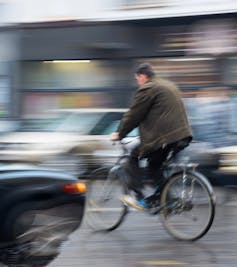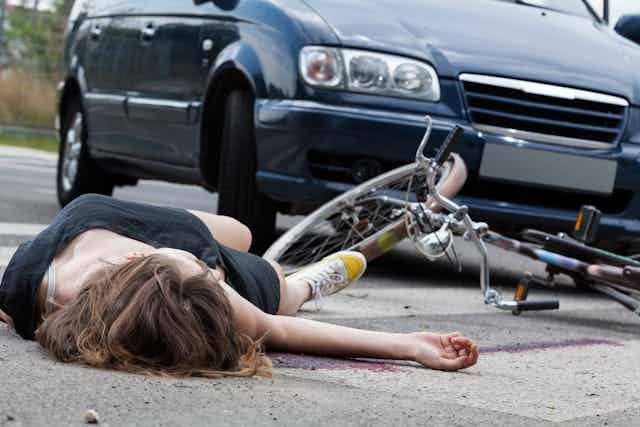Any public conversation about on-road cycling in Australia seems to have only one metaphor for the relationship between drivers and cyclists: equal reciprocity.
An utterance like “Drivers must respect cyclists’ space on the road” must inevitably be followed by something like “For their part, cyclists must ride responsibly and obey the road rules.”
For instance, the campaign promoting a new road safety law in New South Wales tells us:
Drivers, bicycle riders and pedestrians all need to Go Together safely. We should all respect each other’s space and ensure that everyone stays safe.
Most cyclists hardly need to be reminded to respect the space of a two-tonne vehicle travelling at 80km/h just centimetres from their elbow. Yet the wording, as well as the fines imposed, suggests cyclists have as much power to disrespect drivers’ space as vice versa.
The idea that the space someone’s car occupies on the road is personal space, where the car is treated as a proxy body with its own right not to be molested, shows just how far this notion of reciprocity has gone.
Further reading: Here’s why the recent changes to NSW cycling laws may be a good move
Locked into a way of thinking about equality
Why does the metaphor of equal reciprocity so powerfully organise our thinking about a relationship that is so clearly asymmetrical? One explanation is that these debates go on in a public sphere subject to a simplex version of philosophical liberalism wherein all things must be treated as equal.
As Patrick Stokes argues for hierarchies of racial difference, attributing an abstract equality to human beings tends to erase real differences in power and privilege. Public conversations about cycling in Australia erase the reality that cyclists’ safety is to a very large extent not in their own hands, but in those of drivers.
David Graeber observes that reciprocity is our default way of thinking about equality. It’s synonymous with:
… the sense of equity, balance, fairness and symmetry, embodied in our image of justice as a set of scales.
Almost everyone continues to assume that in its fundamental nature, social life is based on the principle of reciprocity…
If we think of the road in this way, it seems reasonable that all cyclists have to do to “earn the respect” of drivers is to conspicuously obey the road rules and not complain too much when “equal” penalties are applied. Many cyclists feel this way. For me, however, they are suffering the lycra equivalent of Stockholm syndrome.
For what if the road is not democratic and egalitarian? I don’t deny that driver-cyclist interactions are very often co-operative, respectful and convivial. But all too we see other kinds of relations played out, based on hierarchy, marginalisation, othering, domination, exclusion, intimidation and violence.
When we try to make sense of this within a reciprocity mindset, we usually say such behaviour is deviant, involving anti-social individuals. It’s a partial explanation, but not a total one.
Automobility rules the road
The fact is the Australian road is not a neutral space. It is ordered by what sociologist John Urry calls the system of automobility.
Urry argues that this is the most transformative system the world has ever seen, one that puts the motorised vehicle at its centre. All other forms of travel, he says:
… have to find their place within a landscape predominantly sculpted by the car system.
As well as all the economic and political interests invested in this system, both public and private, we need to consider the social and cultural meanings these produce around the automobile.
In Australia, ideas of maturity, freedom and autonomy are powerfully entwined with the mythos of the car. These “cultural preferences” are so strong that they often act to erase cyclists’ legal rights and status not only on the road, but also in the courts and when dealing with police.
When cyclist meets driver on the road, both are notionally equal individuals encountering each other in a democratic, rule-governed and neutral public space. But only if the driver chooses to make it like this. Otherwise, they are in a deeply asymmetrical relation, both physically and culturally.
Further reading: Contested spaces: ‘virtuous drivers, malicious cyclists’ mindset gets us nowhere

At times as a cyclist among the cars I feel like an insurgent in hostile territory. By now some readers might assume I am advocating cyclist rebellion and lawless riding. I’m not. Cyclists should do their best to be civil and rule-abiding on the road, at least where it doesn’t put us in danger.
At the same time, we can’t expect great or immediate results from this offer of reciprocity to the drivers around us. To suggest that the person at the wrong end of a heavily unequal relationship can gain recognition and equality simply by offering to “respect the space” of the dominant subject is wishful thinking.
I despair that mainstream bicycle advocacy has to be limited to something like the “metre matters” law. For me, this is the political equivalent of pleading “Please don’t kill us!” – and this law has been applied only a handful of times to penalise drivers.
Many who support this law concede it is mainly useful as a means of publicity and driver education rather than as a legal tool. Courts having long had other means to punish at-fault drivers in car-on-bike crashes if they so chose.
Law should reflect on-road realities
While at first glance the one-metre rule may seem like a special legal protection for a class of vulnerable road users, it in fact functions as a wishful attempt at recognising and enacting rights and protections that have long existed in law.
I ride daily in Canberra and know many cyclists. Anecdotally, the new law hasn’t made a jot of difference to how people drive or to how police and courts deal with cyclists who get hit or harassed.
Readers may object that the law can do no more than extend equal rights and protections to all road users. But that’s not true. Strict liability legal regimes go beyond this to offer special rights and protections to vulnerable road users.
Policymakers in all but five European Union nations accept that all road users are not equal. They recognise the failure of a principle of one-to-one reciprocity whereby we’re all safe because we all have the same formal status and follow the same rules.
These jurisdictions prefer a communitarian approach that acknowledges some groups need “special treatment” to create a level playing field.
There’s little doubt a strict liability regime is at present “politically impossible” in car-centric Australia. However, attempts to fix things that assume voluntary reciprocity can work are also destined to fail.
I certainly don’t have the answers, but I do believe we need to think outside the box of mutual reciprocity to make progress.
Further reading: Cars overwhelmingly cause bike collisions, and the law should reflect that

